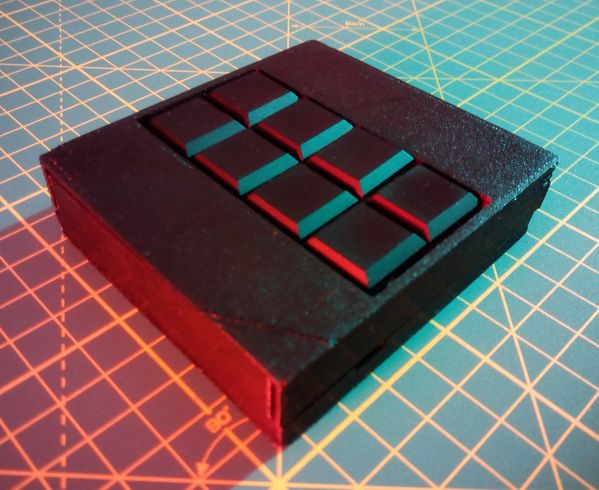Concertina Bauplan/en
Concertina Construction plan
The structure of Oskar Concertina essentially consists of a microcontroller (ESP32) and 8 keys. The replica is beginner friendly. You only have to solder (leaded) components with through-hole plating. You can have the board made by a board manufacturer. The 3D printing of the case, with 0.4 mm nozzle diameter of a Kossel 3D printer, takes about 4 hours with activated support structures. The assembly takes about 1 hour. The material costs amount to approx. € 50.
Inhaltsverzeichnis
Preparation
To build Oskar Concertina you need material, tools and software.
- material bill of material
- tools tools list
- 3D printer
- Soldering iron and optional third hand with magnifying glass
- side cutter
- flat screwdriver 4.5 to 5 mm wide
- Hexagon socket wrench 2 mm
- Carpet knife and metal file
Electronics soldering
- First solder only the components above the microcontroller board Wemos LolinD32. Solder the resistor and only the 4 keys above the LolinD32. Attention! The solder joints of these components are then covered by the LolinD32 and can no longer be soldered after soldering the LolinD32! The 4 keys next to the LolinD32 must not be soldered to leave space for soldering the LolinD32!
- Now you can solder on LolinD32. The pin headers come between the PCB and the LolinD32 with the long pins pointing down towards the LolinD32. Solder the LolinD32 pins BAT, 13, 12, 14, 27, 26, 25, 33, 32 as well as the two GND and their adjacent pins.
- Then solder the remaining components (LiPo plug, on/off switch and 4 keys), and you can switch from the soldering station to the computer.
Flash firmware
If you haven't installed the "Espressif IoT Development Framework" yet, follow the installation instructions of Espressif.
Download the source code of the Oskar ESP32 Firmware! There you will find a download button or the necessary git commands. Establish the USB cable connection between your computer and Oskar Concertina!
Change to the downloaded (and if necessary unpacked) directory and flash the Oskar Concertina ESP32 firmware to the microcontroller with the command "make flash". Test with "make monitor" if all keys deliver signals. Each release of a key is displayed as a bit of one byte on the monitor!
Establish a Bluetooth connection with your smartphone (or other Bluetooth enabled device that accepts Bluetooth HID keyboards)! Oskar Concertina can only pair with a new device for a limited time (30 seconds) after switching on. If it doesn't work immediately, disconnect Oskar Concertina from the power supply (via USB cable or LiPo battery) and repeat the pairing process within 30 seconds. The connection to the LiPo battery is established via the on/off switch (switch on the inner position) or interrupted (switch on the outer position).
Einbau
Entgrate den frischen 3D-Druck, falls nötig! Die Schrauben und die Magneten müssen leicht durch die vorgesehenen Löcher passen. Ich kann dir dazu ein Teppichmesser und eine Metallfeile empfehlen.
Schraube die Gewindeeinsätze in die vorgesehenen Löcher des Deckels.
Positioniere die Platine auf dem Deckel!
Lege den LiPo-Akku Schutz auf die Tastenlötstellen neben dem LolinD32 und verbinde den LiPo-Akku mit der Platine! Schraube die Magneten auf die zwei langen Schraubenfassungen!
Die Magneten auf die zwei langen Schraubenfassungen schrauben ist ein bisserl ein Geschicklichkeitsspiel, weil die starken Magnete unvorhergesehene Bewegungen beim Schrauben vollführen.
Positioniere die Bodenplatte und achte dabei, dass der LiPo Akku auf dem LiPo-Akkuschutz liegt und du das Kabel des LiPo Akkus nicht einzwickst! Dann kannst du die Bodenplatte festschrauben.
Die Schrauben nicht zu fest anziehen. Wir arbeiten mit Metallschrauben in Kunststoff, der brechen kann. Die Schrauben sollen alles am Platz halten und kein Spiel bieten. Die Schrauben müssen aber keine größeren Zugkräfte als der Magnet auf Metall ausübt aufnehmen.
Anwendung
Damit du Oskar Concertina schnell auf der Smartphonerückseite befestigen und wieder lösen kannst, lege zwei dünne Metallplatten an die Stelle der Magneten zwischen Smartphonehülle und Smartphone. Leicht geht das, wenn du Oskar Concertina mit den Magneten nach oben und die Smartphonehülle darauf legst. Wenn du jetzt die Metallplatten in die Smartphonehülle legst, werden sie ihren Platz magnetisch finden.
Aber nicht nur am Smartphonerücken ist die kleine Tastatur nützlich, auch als Fernbedienung für Smartphone, Computer oder TV bietet Oskar Concertina interessante Möglichkeiten. LiPo-Akku lässt sich über USB-Kabel laden, wenn der Ein/Aus-Schalter "Ein" ist (Schalter auf der inneren Position).
Wenn du die Blindenschrift Braille noch nicht beherrschst, ist jetzt die beste Gelegenheit Braille zu lernen. Wenn du keine Lust auf Braille hast, kannst du auch selber ein Tastaturlayout für die 8 Tasten entwerfen. Dazu änderst du die Einträge in der Tabelle "chord_id_keycode" in oskar_esp32/main/main.c. Oder du entwickelst einen über Umschalttasten erreichbaren Modus nach den Vorlagen Pfeil- oder WASD-Modus (arrow_modus, wasd_modus).
Viel Vergnügen beim Drücken der Knöpfe.
Weiterführende Links
- Projektarchiv Oskar Concertina
- Website Oskar
- Erich Schmids 8 Keys Braille
- Smartphone und Oskar Concertina Video
<html5media height="360" width="640">https://www.youtube.com/watch?v=q0peQTYuEqs</html5media>
